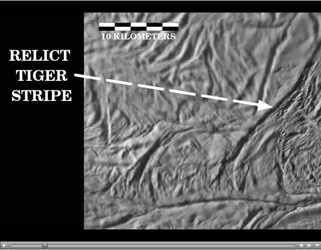Reconstructing the Past on Enceladus

Movie Clip
Click on the image for the movie
This video demonstrates two examples of the interpretation of tectonic spreading along the "tiger stripe" fractures in the south polar terrain of Saturn's moon Enceladus.
The first part of the video shows a simple example in which an old relict tiger stripe is believed to have lost its tip after it was sheared off by tectonic forces and pushed away from its parent by spreading. In the meantime, the parent tiger stripe has managed to regenerate a replacement tip, probably by the creation of new icy crust from upwelling soft ice. The orphaned "clone" now sits by itself, connected to the parent only by two parallel fault lines.
The movie shows that, if the orphaned tiger stripe tip can be slid along the parallel faults back into place on the parent rift, the fit is remarkably good. Striated material between the clone and the replacement tip represents new icy crust material that must have been created during the spreading process.
The second part of the video demonstrates how this video-reconstruction technique can be used to infer a possible spreading history of the region between two tiger stripes: Alexandria Sulcus and Cairo Sulcus. The process begins by snipping-out and closing the gap that corresponds to Alexandria Sulcus and its upraised flanks. The gap is closed by matching the remaining right and left edges like a jigsaw puzzle. The closure is accomplished by sliding along a prominent fault nearly perpendicular to one end of Alexandria. This segment of the video is repeated four times with arrows that mark previously offset features that come into alignment after Alexandria is closed.
Next, Cairo Sulcus is closed along a lower fault that is parallel to the one along which Alexandria was closed. After the Cairo is removed, the closure is continued along the same fault until all of the intervening terrain has been removed. During this process, a mysterious 14-kilometer-sized elliptical feature appears by matching a semi-circular feature that previously existed on the right side of Cairo with the left side of an oval-shaped feature that exists between Alexandria and Cairo. In this way, the gap between Cairo and Alexandria can be closed completely, but there remains a length of the fault that suggests even more spreading may have occurred. Closing the gap all the way along this fault results in the reappearance of a feature that resembles the elliptical structure seen earlier. This feature is perhaps a relict impact crater or the surface expression of a rising warm diapir or icy convection cell.
This video was created based on images of the south pole of Enceladus taken from this map, see PIA11126.
The Cassini-Huygens mission is a cooperative project of NASA, the European Space Agency and the Italian Space Agency. The Jet Propulsion Laboratory, a division of the California Institute of Technology in Pasadena, manages the mission for NASA's Science Mission Directorate, Washington, D.C. The Cassini orbiter and its two onboard cameras were designed, developed and assembled at JPL. The imaging operations center is based at the Space Science Institute in Boulder, Colo.
For more information about the Cassini-Huygens mission visit http://saturn.jpl.nasa.gov/. The Cassini imaging team homepage is at http://ciclops.org.
